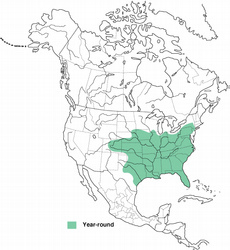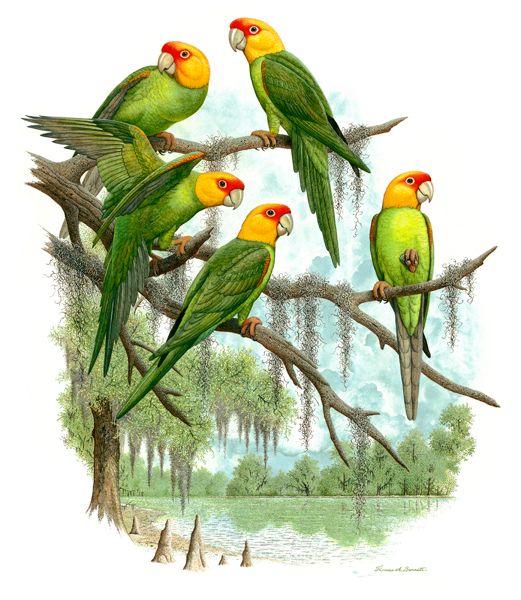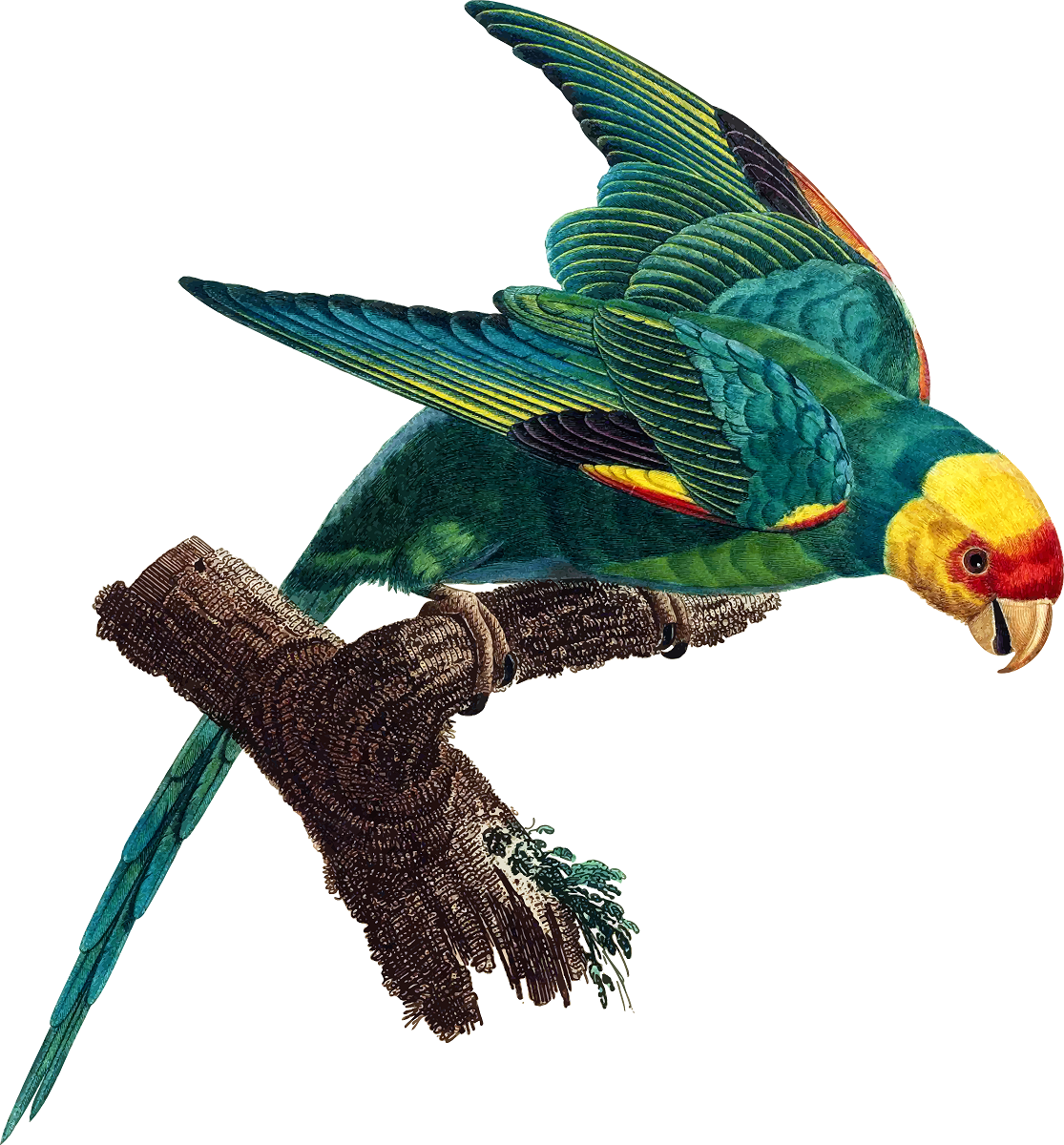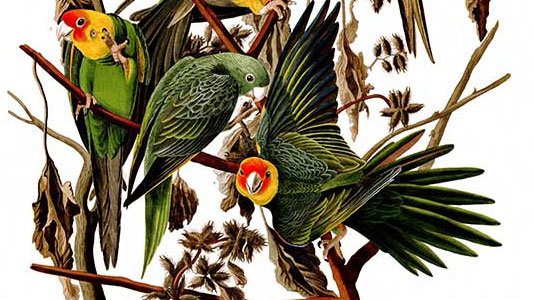History and Appearance
The Carolina parakeet (Conuropsis carolinensis) was the only parrot native to North America north of Mexico and its range was mostly the Eastern United States. It was a medium sized - about 12 inches - with a long tail. It's feathers were mostly green with a yellow neck and head, red or orange cheeks, and a pale horn-colored beak.
This lovely bird colonized North America about 5.5 million years ago. Rough estimates have been made about their historical population density and it is estimated anywhere from 20,000 to 2.5 million birds could have lived in 2 square kilometers. The densest population was in Florida with numbers in the hundreds of thousands.
It was rarely spotted outside of Florida after 1860. The last know wild specimen was killed by a farmer in Florida in 1904. The last captive specimen died in the Cincinnati Zoo on February 21, 1918.
Ecology
The Carolina parakeet resided in deciduous forests and edges of the Eastern U.S., as far North as the Great Lakes region and bottomland hardwood forests as far West as Nebraska. It was know to only nest in tree cavities and the birds gathered in large flocks where they could be heard for miles because of their loud, raucous chatter.
It's small beak was perfect for feasting on plants such as thistle and sand burs, seeds of various trees and fruits like apples and figs. The Carolina parakeet is the only know species to eat Cockle-bur, a plant containing glucoside, a poison that is highly toxic to the liver. Cats were known to die after eating Carolina parakeets which had ingested the Cockle-bur.

Historical range of the Carolina parakeet Image Source
Demise and Extinction
Several factors led to the eventual extinction of this remarkable bird.
Habitat Loss
Deforestation making way for agriculture destroyed much of their homes and territory. This seems to be the main reason we lose species to extinction.
Fashion
In Europe and America it was fashionable for ladies to have hats decorated with the wings, heads, plume, or even the whole bodies of birds. Called "fancy feathers" by Harper's Bazaar, these had to be plucked from the rarest of birds. In 1900 the North American millenery - hatmaking - industry employed 83,000 people.

Picture source
"Unfortunately, the demand for feathers began to damage the migratory bird population, and by 1918, lobbying groups such as the Audubon Society had succeeded in a federal ban on certain types of feathers, the Migratory Bird Treaty Act of 1918." Source
Companionship
It could go without saying that these birds were kept as pets. Humans seem to be drawn to exotic species ownership. This may not have been such a terrible thing because the Carolina parakeet bred well in captivity. However, pets owners were apathetic and took no advantage of this fact and they became extinct nonetheless.
Honeybee Introduction
Honeybees were introduced to North America during the 1600's by Europeans fleeing wars, poverty, land laws and religious persecution. Guess where honeybees prefer to nest? Tree cavities just like the Carolina parakeet.
Farmers
The birds were seen as a nuisance because they would eat and damage crops. The birds behavior only accelerated the farmers ability to quickly kill them. Their flocking behavior worked against them and if one bird was making distress calls, more birds would flock around, creating more targets for the farmers.
Poultry Disease
With the increase in farming and agriculture, there was a dramatic increase in poultry populations. Chickens carry a number of diseases such as fowl pox, newcastle disease, bronchitis, avian flu, coryza, and swollen head syndrome - just to name a few. The chickens roaming free in barnyards, fields and woods would most certainly have come into contact with the birds and in turn infecting the parakeets with their diseases.
Final Thoughts
Parrots are the most threatened Avian group on Earth. Today, a little more than 700 Carolina Parakeet skins and over 15 skeletons are housed in museums all across the world. Scientists have used these skins and skeletons to examine these birds since no surveys were done of these birds while they were living." Source Historical ecology studies of the Carolina parakeet may help conservation efforts of currently threatened parrots but the world has changed so much it is hard to draw useful conclusions. Habitat destruction and human encroachment always seem to be the underlying causes for species extinction. Until large scale conservation and education efforts are implemented, endangered and threatened species will continue to disappear.

Image Source
Thanks for peeping!
Kiristin
A little bit about @kiristin
I am fairly new to the Steemit Community and I am trying to get my bearings and decide the direction of my blog because it is a work in progress.
I was born, raised and currently reside in North Carolina, a state in the USA. I have three dogs and a cat and I love hiking, being outdoors, learning new things, going on adventures, camping, swimming, reading, running, kayaking, rock climbing, and eating…just to name a few. I am 36 years old and have no idea what I am doing with my life. It is a constant work in progress too.
I am excited to share my knowledge and other interesting facts about science, ecology, nature, hiking, camping and travel as well as my pictures I have taken about these subjects.
I began my first series on February 22nd, 2018 called “Thirsty for Knowledge Thursday - If You Don't Know, Now You Know..."Every Thursday I'll be tossing Jeopardy worthy knowledge and tidbits at you. You can see my first article here.
Stay Tuned and Happy Steeming!


You received a 10.0% upvote since you are not yet a member of geopolis and wrote in the category of "ecology".
To read more about us and what we do, click here.
https://steemit.com/geopolis/@geopolis/geopolis-the-community-for-global-sciences-update-4
If you do not want us to upvote and comment on your posts concerning earth and earth sciences, please reply stop to this comment and we will no longer bother you with our love ❤️
Downvoting a post can decrease pending rewards and make it less visible. Common reasons:
Submit